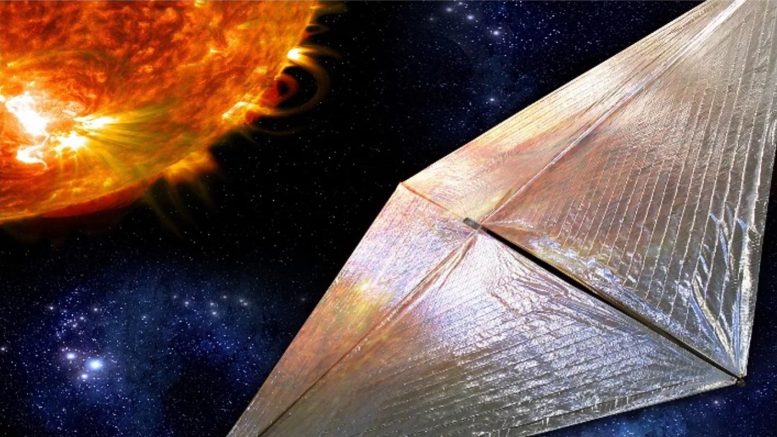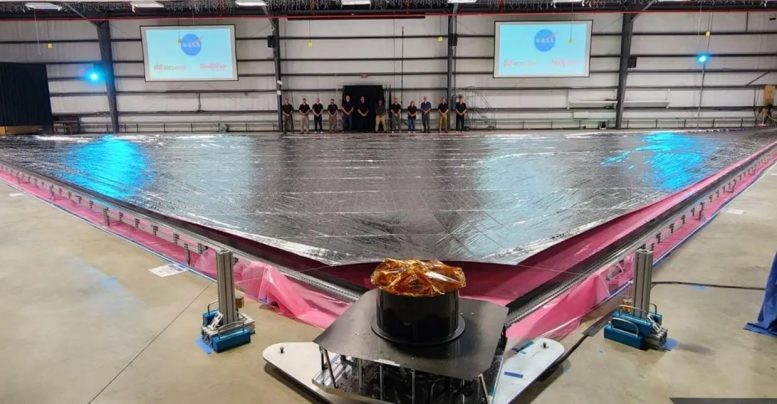
NASA is developing solar sail technology for deep space exploration. This innovative propulsion system, powered by sunlight reflecting off its surface, has recently achieved a new readiness level, making it suitable for future science missions. Solar sails offer a fuel-free, environmentally friendly method of propulsion, capable of propelling low-mass missions to novel orbits and distant planets. Credit: NASA
NASA is pioneering solar sail technology for space exploration, offering an eco-friendly propulsion system that harnesses sunlight. This advancement enables potential missions to study space weather, explore the Sun’s poles, and venture closer to Venus and Mercury.
In his youth, NASA technologist Les Johnson was riveted by the 1974 novel “The Mote in God’s Eye,” by Jerry Pournelle and Larry Niven, in which an alien spacecraft propelled by solar sails visits humanity. Today, Johnson and a NASA team are preparing to test a similar technology.
NASA continues to unfurl plans for solar sail technology as a promising method of deep space transportation. The agency cleared a key technology milestone in January with the successful deployment of one of four identical solar sail quadrants. The deployment was showcased on January 30 at Redwire Corp.’s new facility in Longmont, Colorado.
NASA’s Marshall Space Flight Center in Huntsville, Alabama, leads the solar sail team, comprised of prime contractor Redwire, which developed the deployment mechanisms and the nearly 100-foot-long booms, and subcontractor NeXolve, of Huntsville, which provided the sail membrane. In addition to leading the project, Marshall developed the algorithms needed to control and navigate with the sail when it flies in space.

NASA and industry partners used two 100-foot lightweight composite booms to unfurl the 4,300-square-foot sail quadrant for the first time on October 13, 2022, at Marshall Space Flight Center, making it the largest solar sail quadrant ever deployed at the time. On January 30, 2024, NASA cleared a key technology milestone at Redwire’s new facility in Longmont, Colorado, with the successful deployment of one of four identical solar sail quadrants. Credit: NASA
Solar Sail Technology and Its Advancements
The concept behind the solar sail is simple yet revolutionary. It operates by harnessing sunlight reflection for propulsion, similar to how wind propels a sailboat. While just one-quarter of the sail was unfurled in the deployment at Redwire, the complete sail will measure 17,780 square feet when fully deployed, with a thickness of less than a human hair at 2 and a half microns. The sail is made of a polymer material coated with aluminum.
NASA’s Science Mission Directorate recently funded the solar sail technology to reach a new technology readiness level, or TRL 6, which means it’s ready for proposals to be flown on science missions.
“This was a major last step on the ground before it’s ready to be proposed for space missions,” Johnson, who has been involved with sail technology at Marshall for about 25 years, said. “What’s next is for scientists to propose the use of solar sails in their missions. We’ve met our goal and demonstrated that we’re ready to be flown.”
A solar sail traveling through deep space provides many potential benefits to missions using the technology because it doesn’t require any fuel, allowing very high propulsive performance with very little mass. This in-space propulsion system is well-suited for low-mass missions in novel orbits.
“Once you get away from Earth’s gravity and into space, what is important is efficiency and enough thrust to travel from one position to another,” Johnson said.
“A solar sail achieves that by reflecting sunlight – the greater the size of the sail, the greater thrust it can provide.”
— Les Johnson, NASA technologist
Future Applications and Environmental Benefits
Some of the missions of interest using solar sail technology include studying space weather and its effects on the Earth, or for advanced studies of the north and south poles of the Sun. The latter has been limited because the propulsion required to get a spacecraft into a polar orbit around the sun is very high and simply not feasible using most of the propulsion systems available today. Solar sail propulsion is also possible for enhancing future missions to Venus or Mercury, given their closeness to the Sun and the enhanced thrust a solar sail would achieve in the more intense sunlight there.

NASA Marshall Space Flight Center technologists Les Johnson and Leslie McNutt at Redwire Space on January 30, 2024, following a successful solar sail deployment test. NASA cleared a key technology milestone at Redwire’s new facility in Longmont, Colorado, with the successful deployment of one of four identical solar sail quadrants. Credit: Redwire Space
Moreover, it’s the ultimate green propulsion system, Johnson said – as long as the Sun is shining, the sail will have propulsion. Where the sunlight is less, he envisions a future where lasers could be used to accelerate the solar sails to high speeds, pushing them outside the solar system and beyond, perhaps even to another star. “In the future, we might place big lasers in space that shine their beams on the sails as they depart the solar system, accelerating them to higher and higher speeds, until eventually they are going fast enough to reach another star in a reasonable amount of time.”









Be the first to comment on "Harnessing Helios: The Science Behind NASA’s Solar Sail Breakthrough"